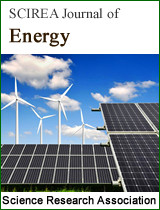Hydrokinetic Energy Production from Downstream Currents in the Exit of Hydroelectric Power Plant: A Review
DOI: 398 Downloads 16494 Views
Author(s)
Abstract
The quest for new renewable energy resources is intensifying, with a view to greenhouse gas emission reduction and in the context of the climate-food-water-energy nexus. A hitherto ignored though widely available renewable energy resource lies in downstream water flow exiting from existent hydroelectric power plant. The techno-economic feasibility of this renewable energy resource is enhanced by two factors: mature hydrokinetic river turbine technology and availability of data on the river channel flow downstream of hydro power plant. The main challenge lies in determination of the optimal hydrokinetic turbine placement downstream of hydro power plant. This challenge has stimulated research work both on the tidal and the river current variants of the turbine, turbine fence, and turbine farm layout problems. The renewable energy resource under consideration in this paper is of particular importance to countries with substantial hydro power generation, the leaders in the world at the presente time being in descending order: China, Brazil, and Canada.
Keywords
: Hydroelectric Power; Hydrokinetic Energy; Downstream Channel; Renewable Energy; Turbine Placement; Optimisation
Cite this paper
T. Nzualo, R.Y.Qassim, P.C.C, Rosman,
Hydrokinetic Energy Production from Downstream Currents in the Exit of Hydroelectric Power Plant: A Review
, SCIREA Journal of Energy.
Volume 3, Issue 1, February 2018 | PP. 1-10.
References
| [ 1 ] | Endo A, Tsurita, I, Burnett, K., Orencio, PM. A review of the current state of research on the water, energy, and food nexus. Journal of Hydrology: Regional Studies 2015 doi: 10.1016/j.ejrh.2025.11.010. |
| [ 2 ] | Borthwick AGL. Marine renewable energy seascape. Engineering 2016:2:69-78. |
| [ 3 ] | International Hydropower Association, 2014, www.hydropower.org (accessed 19-05-2016). |
| [ 4 ] | Energy Information Administration, 2012, www.eia.gov, (accessed 19.05.2016). |
| [ 5 ] | Karsten R, Swan A, Culina, J. Assessment of arrays of in-stream tidal turbines in the Bay of Fundy. Philosophical Transactions of the Royal Society 2015 doi: 10.1098/rsta.2012.0189. |
| [ 6 ] | Iyer AS, Couch SJ, Harrison, GP, Wallace, AR. (2013) Variability and phasing of tidal current energy around the United Kingdom. Renewable Energy 2013; 343-357. |
| [ 7 ] | Zhang Y-l, Lin Z, Liu Q-l. Marine renewable energy in china: Current status and perspectives. Water Science and Engineering 2014; 7(3) 288-305. |
| [ 8 ] | González-Gorbeña E, Rosman PCCR, Qassim RY. Assessment of the tidal current energy resource in São Marcos Bay, Brazil. Journal of Ocean Engineering and Marine Energy 2015; 1, 421-433. |
| [ 9 ] | Carpman N, Thomas K. Tidal resource characterization in the Folda Fjord, Norway. International Journal of Marine Energy 2016; 13, 27-44. |
| [ 10 ] | Ortega-Achury SL, McAnally WH, Davis TE, Martin JL. Hydrokinetic Power Review. Mississipi State University 2010. |
| [ 11 ] | Electric Power Research Institute. Assessment and mapping of the riverine hydrokinetic resource in the continental United States 2012. |
| [ 12 ] | VanZwieten J, McAnlly W, Ahmad J, Davis T, Martin J, Bevenlhimer M, Cribbs A, Lippert R, Hudon T, Trudeau M. In-stream hydrokinetic power: Review and appraisal. ASCE Journal of Energy Engineering 2015; 141(3). |
| [ 13 ] | Petrie J, Diplas P, Gutireerz M, Nam S. Characterizing the mean flow field in rivers for resource and environmental impact assessments of hydrokinetic energy generation. Renewable Energy 2014; 393-401. |
| [ 14 ] | Kalnach A, Kalnach J, Mutule, A, Persia U. Potential of the Lower Daugava for siting hydrokinetic turbines. Latvian Journal of Physics and Technical Sciences 2013(2), doi: 10.2478Ipts-2013-0007. |
| [ 15 ] | Kalnacs A, Kalnacs J, Mutule A, Persis U. Methods for estimation of the riverflow potential for hydrokinetic power generation. Latvian Journal of Physics and Technical sciences 2014(2), doi: 10.2478/Ipts-2014-0008. |
| [ 16 ] | Khan MJ, Bhuyan G, Iqbal MT, Quaice JE. Hydrokinetic energy conversion systems and assessment of horizontal and vertical axis turbines for river and tidal applications: A technology status review. |
| [ 17 ] | Søres K. Small-scale water current turbines for river applications. Zero Emission Organisation Report, 2010. www.zero.no, (accessed 14.05.2016). |
| [ 18 ] | Güney MS, Kaygusuz K. Hydrokinetic energy conversion systems: A technology status review. Renewable and Sustainable Energy Reviews 2010;14:2996-3004. |
| [ 19 ] | Vermaak HJ, Kusakana K, Koko SP. Status of micro-hydrokinetic river technology in rural applications: A review of the literature. Renewable and Sustainable Energy Reviews 2014; 29:625-633. |
| [ 20 ] | Kumar D, Sarkar S, A review on the technology , performance, design optimization, reliability, techno-economics and environmental impacts of hydrokinetic conversion systems. Renewable and Sustainable Energy Reviews 2016; 58:796-813. |
| [ 21 ] | Lalander E, Leijon M. In-stream energy converters in a river – Effects on upstream hydropower station. Renewable Energy 2011;36;399-404. |
| [ 22 ] | Liu Y, Packey DJ. Combined-cycle hydropower systems – The potential of applying hydrokinetic turbines in the tailwaters of existing conventional hydropower stations. Renewable Energy 2014; 66:414-426. |
| [ 23 ] | Shafei, ARS, Ibrahim DK, Ali AM, Younes MAA, El-Zahab E-DA. Novel approach for hydrokinetic turbine applications. Energy for Sustainable Development 2014; 66:414-426. |
| [ 24 ] | Arango MA. Resource assessment and feasibility study for use of hydrokinetic turbines of the Priest Rapids Project. M.Sc. thesis, University of Washington, 2011. |
| [ 25 ] | Farahani RZ, Hekmatfar M, Fahimnia B, Kazemzadeh N. Hierarchical facility location problems: Models, classifications, techniques, and applications. Computers and Industrial Engineering 2014; 68:104-117. |
| [ 26 ] | Calley DM, Fuke SSW, Kramer SC, Piggott MD. Renewable Energy 2016; 85:215-227. |
| [ 27 ] | González-Gorbeña E, Qassim RY, Rosman, PCC. Optimisation of hydrokinetic turbine layouts via surrogate modelling. Renewable Energy 2016; 93:45-57. |

